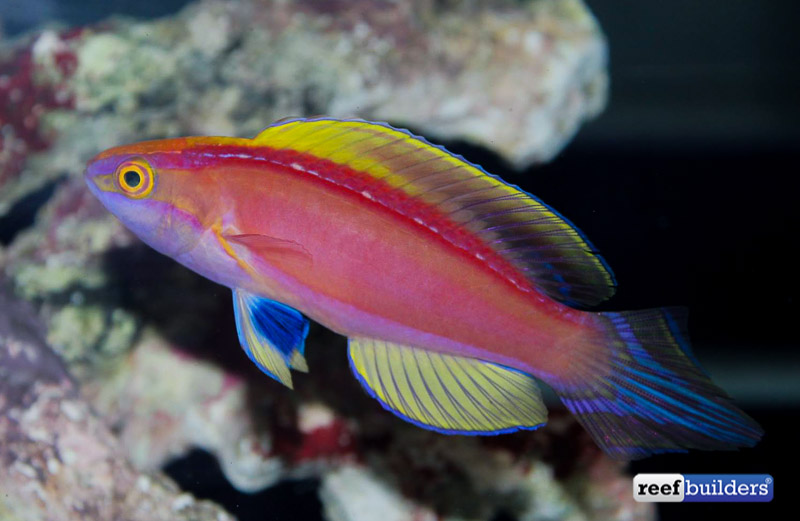Among the two dozen or so most commonly encountered fairy wrasses, the elusive rose banded fairy wrasse, Cirrhilabrus roseafascia is not among them. This species is a relative newcomer to the documented fairy wrasse group, having only been described in 1982.
Despite having a rather broad distribution that ranges from Fiji, New Caledonia, Palau, samoa and Cebu Philippines, the rose banded fairy wrasse is not a common import from any one place, although Cebu is the most likely origin for collection for the aquarium market. That being said, this particularly stunning specimen actually comes to us from the Coral Sea, Australia.

Being a part of the lanceolatus group of fairy wrasses, the rose banded fairy wrasse has some stiff competition for attention from its fellow congeners. If you haven’t heard of the rose banded fairy wrasse, perhaps it’s because C. roseafascia has to compete with the smaller and much more available Cirrhilabrus cf. lanceolatus and the larger and much showier Pintail fairy wrasse, the ‘true’ Cirrhilabrus lanceolatus.
The rose band fairy wrasse and true pintail fairy wrasse are sister species with a very similar appearance, both in body shape, coloration, and patterning. The main distinguishing characteristic between these two stunning fish is that the rose band really has a pink stripe on the dorsal part of its body, and more pronounced yellow coloration to its dorsal, anal and pelvic fins.

Meanwhile the real deal lanceolatus pintail has a blue stripe on the topside of its body, fins that are much less yellow, a much more pronounced sword or lance-shaped tail. Since the true pintail C. lanceolatus is so far only known from Southern Japan, chances are that you won’t see this species outside of its home country and if you do, it’ll be for a great deal more money than the more basic C. roseafascia.
That being said, the particular specimen of rose band fairy wrasse in focus today is a supermale that can hold a candle to the most exquisite species of wrasses out there. Perhaps because it is Australian, collected by Cairns Marine, at a depth of 99 meters (325 feet), in the Coral Sea, this specimen of C. roseafascia is truly representing the species well in the marine aquarium hobby.

As you might expect, this stunning fairy wrasse went to Blue Harbor in Japan where Koji & Co. can never get enough of the majesty of fairy wrasses. The special fish is now living in a hobbyist aquarium with other exemplary specimens of exotic reef fish, with reduced lighting and cooler temperatures to help this fish settle in to captive life and continue to live up to its full potential. Once again, big thanks to Kengo Zeze for the captivating images of this Cirrhilabrus roseafascia which really bring this fascinating fairy wrasse species to life.



